Urban planners can learn a lot simply by observing where cars actually drive (or don’t) after a fresh snowfall. Author and activist Jon Geeting has been photographing ‘sneckdowns‘ (a portmanteau of ‘snowy’ and ‘neckdowns’ or: curb extensions) in Philadelphia for years, highlighting areas that could be converted from vehicular to pedestrian use. Remarkably, his documentation has done far more than just create general interest — it has actually helped to reshape intersections.
A series of Philadelphia ‘sneckdowns’ documented by Jon Geeting on This Old City
A few years ago, Geeting’s images were used in a campaign to convince the city to modify a confusing and dangerous intersection at 12th and Morris. His observations aided in the identification of underused road space, which could be adapted to better uses, including:
- Shortening pedestrian crossing time
- Calming vehicle traffic around intersections
- Allowing planners and road engineers to see opportunities
- Reducing asphalt surfaces and increasing plant surfaces to improve the absorption of rainwater by the soil, minimizing runoff and floods
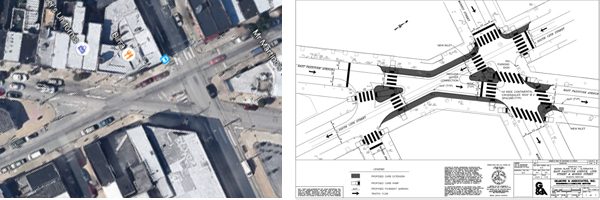
Geeting credits Sam Sherman, the former Executive Director at Passyunk Avenue Revitalization Corp, and his successor, Bryan Fenstermaker, with turning Geeting’s documentation into an advocacy tool. “Sam is one of Philly’s original urbanist agitators, so it didn’t take any convincing from me,” recalls Geeting. “He brought my images of the 12th and Morris intersection to the Commerce and Streets Departments on his own and made the internal case to the city.”

Currently the Director of Engagement at Philadelphia 3.0, a PAC devoted to local political reform, Geeting has also written for PlanPhilly, Next City, and other local publications on political and urban topics. He became interested in planning issues while biking the streets of New York City “around 2007, when Janette Sadik-Khan was head of NYC DOT and the city was really aggressively transforming the streets with things like car-free Times Square and the pedestrian plaza program. It was a pretty exciting time to be following this arena of politics.” He also started reading Streetsblog, the founder of which, Aaron Naparstek, originally coined the term ‘sneckdown’ for natural snowy bump-outs.
Geeting is working on two more sneckdown-driven pedestrian plazas with his neighborhood association in Fishtown, but he is not alone in his approach. “The first Philadelphia example of a sneckdown image translating into real change was in West Philly,” he says, “at 48th and Baltimore. Prema Gupta, then at University City District, took some photos of snow formations at that intersection” and sold the city on a redesign. “The intersection now has multiple pedestrian plazas with temporary materials like planters, large rocks, and a painted roadway.”
Of course, not every city gets snow, which can complicate matters. But Geeting’s blog readers have suggested other approaches, too — “a lot of people wrote to inform me that flour or other kinds of powder are a pretty common way for street engineers to test where curb lines should be,” and “sometimes parking patterns are a giveaway too. With one of the pedestrian plazas I’m working on, people frequently use the space for temporary parking, but it’s actually not a legal space.”
Still, putting powder out on a road is a somewhat different proposition. When it comes to sneckdowns, there is, of course, nothing illicit going on — modified photographs are simply leveraged to sell the city on new ideas. But Geeting sees advantages to more guerrilla approaches as well, like those documented by Mike Lydon, author of Tactical Urbanism: Short-Term Action for Long-Term Change. Citing Lydon’s findings, Geeting explains that “citizen-led interventions tend to have some staying power, and often aren’t removed even if done illicitly.”
With respect to Philadelphia specifically, though, Geeting notes that the city “now has a process for citizen-initiated pedestrian plazas, which gives people a way to advance ideas even if their local elected official disapproves.” But, he says, “even in places where there is no citizen-led option, making (temporary [and] reversible) changes to streets illicitly can be a good way for citizens to call attention to problems that a city administration may not be aware of, or may be ignoring.”
Interested in becoming more active in your own city? “If you have an idea for a space like this,” Geeting advises, “find a way to test it out temporarily and gather feedback and have conversations with people. Use events like Park(ing) Day or street festivals to do cheap, temporary versions of what you want to do, and gather feedback from people. If you notice an intersection is a problem, chances are that other people probably have as well, and temporarily testing it out is a great way to meet those people, and start organizing for more permanent changes.”
Update: Initially published as a short article, this story was further researched and expanded to become part of The 99% Invisible City, a NYT best-selling book by Roman Mars & Kurt Kohlstedt:
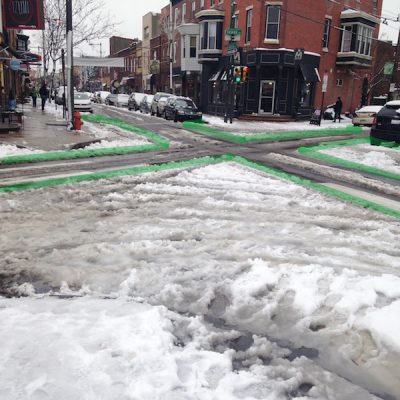
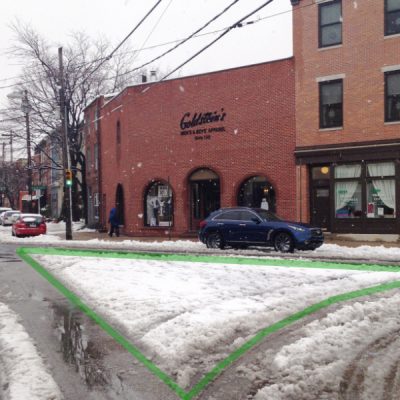
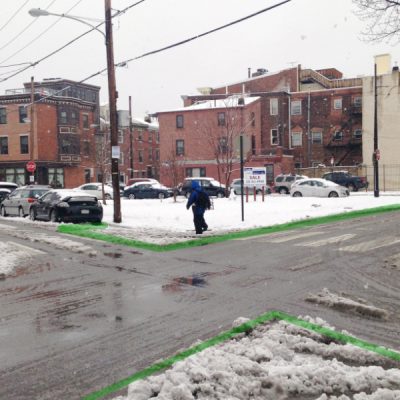
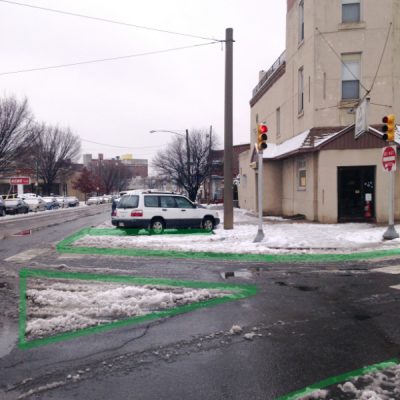
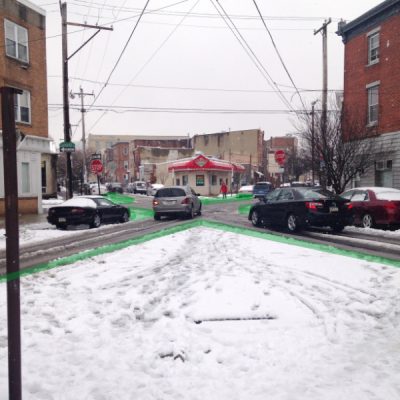
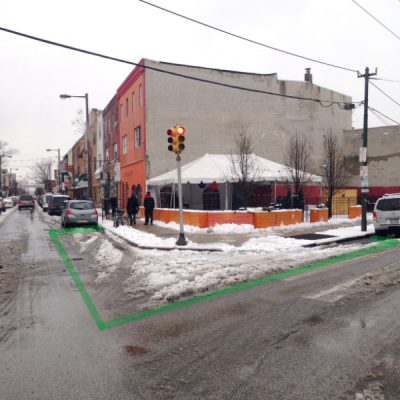

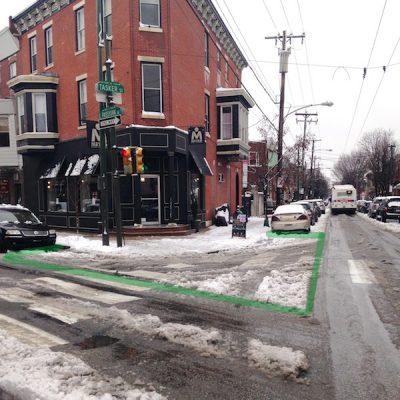
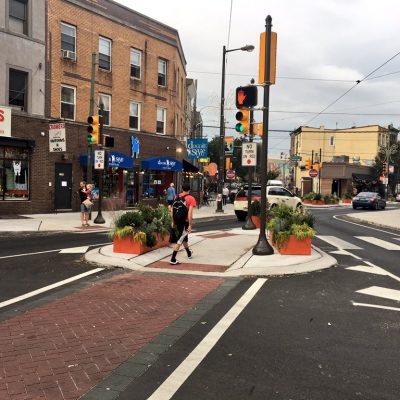
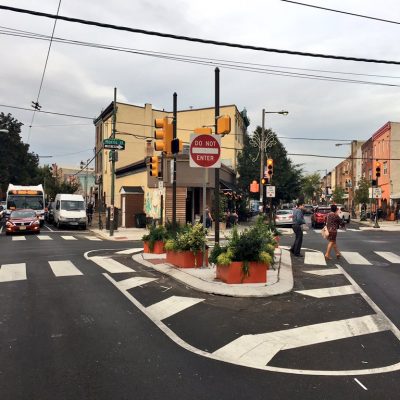



Comments (3)
Share
I don’t think I agree with a lot of the ideas presented in this article. I don’t have a problem with re-designed, more pedestrian-friendly intersections, but I have my reservations about whether sneckdowns can fully be used to illustrate vehicular patterns. For one, when given a choice, people tend to drive where there is no snow. I think we view it as safer. Who knows what is under the snow. There might be a curb hidden by the snow, or there might be a patch of ice that would cause the vehicle to skid. Or maybe the snow is concealing a dangerous item that could puncture a tire. Living in Wisconsin, I’ve seen two-lane roads become one lane during and soon after snow falls because people choose the route they know is safe. Just because traffic tends to narrow in certain conditions doesn’t mean the road should always be one lane. Also, in the video, Geeting makes a case that the sneckdown causes people to slow down when turning a corner. That may be true, but it could also be true that people are slowing down because there’s snow and ice on the road. We alter our driving when driving conditions are unsafe, and we should not assume that a median or curb extension of some kind will produce the same result in safe driving conditions. Plus, I think we should also take into consideration how such sneckdown-inspired obstructions will affect road-clearing vehicles like snowplows, street cleaners, and other vehicles. Such intersections might make conditions safer during certain times of the year, but they also might make the conditions more unsafe during others.
It’s not that I necessarily disagree with the overall sentiment of this piece. It’s just that I suspect that a desire for better (or safer) intersections is leading to conclusions being drawn from data that may not fully support those conclusions.
Although we get plenty of snow in Toronto some reisdents did the same thing with some leaves late last year. http://www.cbc.ca/news/canada/toronto/dave-meslin-sidewalk-toronto-chalk-leaves-1.4427663
The intersection was greatly improved with the leaves.
I agree with David’s comment. While it may be useful in some circumstances, there are definitely other reasons people choose routes in the snow. Many of these result in getting places in a slower more inefficient manor.
Not trying to discount the article entirely, but pros AND cons should be mentioned!